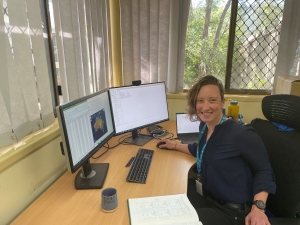Mungbean model upgrade to improve yields with less risk
Date: 04 Jan 2022

The development of a new mungbean simulation model is set to reduce climate risk and yield variability in crops and assist growers in making more informed management decisions to boost their bottom line.
Heather Pasley moved to Australia from America to start building a new and improved version of Agricultural Production Systems sIMulator’s (APSIM’s) computer model for mungbeans, which is currently based on outdated cultivars.
Her work is part of a Grains Research and Development Corporation (GRDC) investment, which has involved collaborations from La Trobe University and CSIRO. The GRDC supported field trials with the University of Queensland were used to gain a deeper understanding of mungbean growth and what influences it.
Dr Pasley said the new model would incorporate a deeper understanding of mungbean growth and physiology, giving greater confidence in what growers could expect from a mungbean crop under different management schemes and climatic conditions.
“Outputs from the model have the potential to provide insight into what sowing dates, water or irrigation regimes and cultivar combinations are optimal for growers in different regions,” she said.
“This work will generate legacy information for the grains industry and provide guidelines for farmers throughout Australia.”
GRDC Senior Regional Manager – North, Gillian Meppem said training, nurturing and motivating the world’s best talent to participate in Australian grains research is key to delivering profitable solutions for Australian grain growers.
“We’ve placed an emphasis on supporting the next generation of scientists and researchers to assist them in delivering world-class grains research, development and extension,” she said.
“While we invest in capacity and ability activities to address specific needs or gaps in the industry, our greatest contribution to improving the grains industry is arguably through investing in research projects and programs like Dr Pasley’s.”
Dr Pasley holds an undergraduate degree in geology and anthropology and a doctor of philosophy in agronomy on nutrient cycling and cropping systems in Kenya and Zimbabwe.
While she’s in Australia, Dr Pasley will continue to expand her professional network and broaden her understanding of dryland farming systems in Australia.
In the future, Dr Pasley wants to develop crop models to help growers and researchers in sub-Saharan Africa improve their agricultural systems.
GRDC is committed to investing in building the capacity and ability of grains researchers so their work can contribute to the enduring profitability of Australian grain growers.
For more information on Dr Pasley’s work, or to read more about the up-and-coming researchers supported by GRDC in the November-December GRDC’s Ground Cover supplement.
Contact details
For interviews
Heather Pasley
0448 500 597
Heather.pasley@csiro.au
Contact
Toni Somes, GRDC Communications Manager – North
0436 622 645
toni.somes@grdc.com.au
GRDC Project Code: ULA1906-002RTX,
Was this page helpful?
YOUR FEEDBACK
